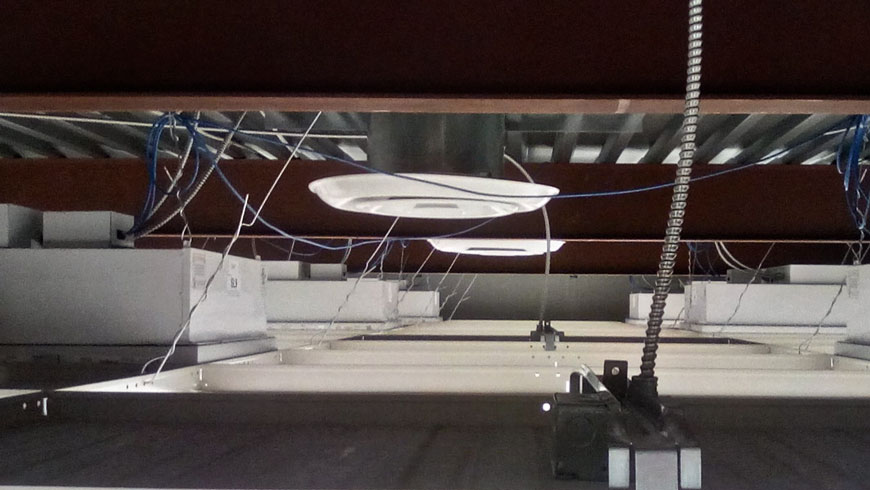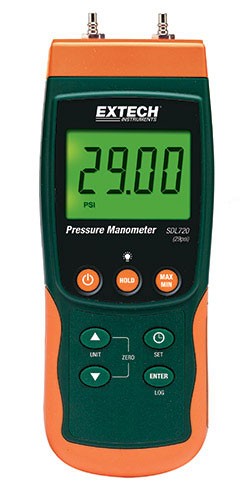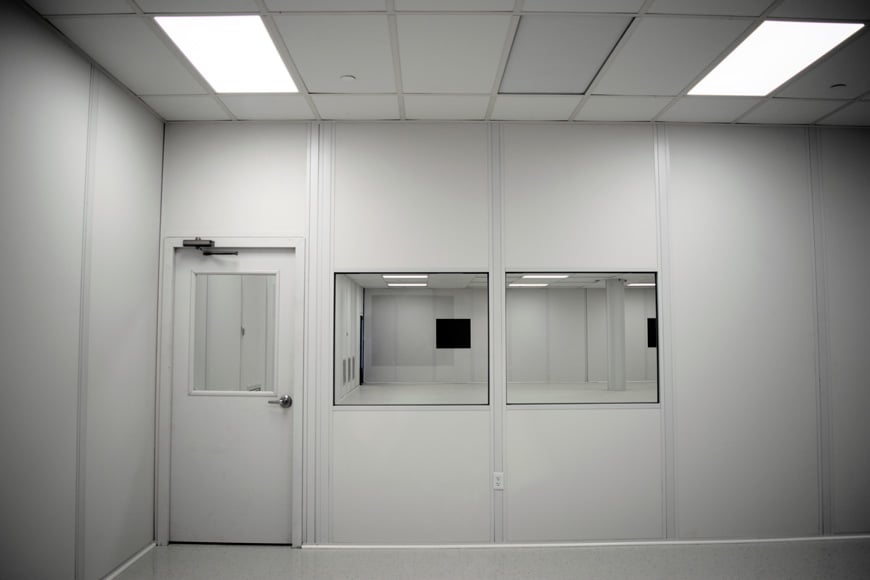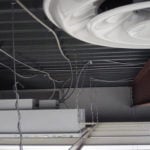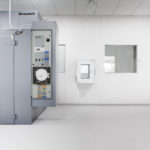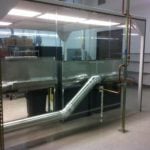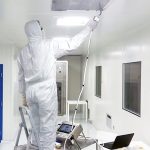Table of Contents
Evaluating and Troubleshooting Cleanroom Performance and Maintenance Schedules
Cleanroom HVAC and fan filter systems vary due to a number of factors, such as overall resistance to airflow (pressure drop), efficiency of filters, fans, motors, air change rates, etc. Airflow requirements are dependent upon many variables such as process contamination generation rates, make-up air, make-up air concentration, the filtration system efficiency, and airflow distribution.
This post will help you answer some of the following questions:
- How often do cleanroom fan filters require replacement?
- What are the most common air testing and measurement instruments for diagnosing cleanroom filter life and performance?
- Is there an industry standard filter performance measurement?
- What are the best practices for monitoring filter status & knowing when to replace filters?
- What are some tips and best practices for HVAC and filtration analysis?
Consider the Variability of the Space
You are Your Own Best Teacher
You are the in-house expert on the operations and conditional environments at your facility. Every business is different as far as how dirty the air is going through the filter, variability, and the overall system design. You will determine when to change the filters and conduct equipment maintenance. The first consideration is usually how dirty and what volume the air handler passes through the cleanroom.
Managing Cleanroom Performance Expectations
Let’s compare control challenges and variability between an ISO 5 space and ISO 8 space. Not only is an ISO 8 room dirtier, but so are its adjacent areas. ISO 8 areas do not require gowning rooms. Increased particulate burdens incur shorter filter life and more frequent replacement.
Consider the variable degrees of particle introduction and the nature of the process that takes place when considering expected filter life. Some cleanrooms may require filter change-outs as often as every 2 – 3 months.
A cleanroom fan filter maintenance schedule is not an exact science. It does take some trial and error to overcome cleanroom nuances and understand repeatable maintenance practices.
Before tearing into the mechanical aspects of the cleanroom, there are a number of spot tests and measurement options for testing fan filter velocity and pressure differentials.
Cleanroom Fan Filter Testing & Monitoring Methods
Test filter face velocity, monitor Magnehelic gauge differentials and finally consider overall room ACH before tearing into mechanical items, gaskets, clamps, blowers, electrical, and housings.
Handheld Digital Manometers for Cleanrooms
A manometer measures and indicates air pressure differential. Equipment ranges between digital and analog forms. Applications include:
- HVAC Ventilation Testing and Balancing
- Laboratory Control
- Fume Hood Performance Testing
- IAQ Investigation
- Industrial Flow Testing
The SDL720 Differential Pressure Manometer features a large LCD display, backlighting, and PC ready data sharing.
- Measurement range: ±29psi (2000mbar)
- 10 selectable units of measure
- Time stamps and stores 99 readings
- SD card in Excel® format for easy transfer
In automatic data logging mode, the meter takes and stores a reading at a user‐specified sampling rate onto an SD memory card.
Extech manometers ship fully calibrated. Need NIST approved documentation? View extended options here.
Cleanroom Magnehelic Gauges
A Magnehelic gauge is an analog manometer which relays positive, negative, or differential pressure readings between adjacent spaces. Two magnets within a sensitive diaphragm control the motion of dial pointer.
The Magnehelic gauge is a real-time indicator of overall room pressure and symptomatic of filter health in the absence of other variables. USP 800 designates a zone only acceptable between -0.01 to -0.03 in WC (Negative Pressure). In most other cleanroom applications, a +0.01 to 0.03 WC (Positive Pressure). Positive pressure cleanrooms prevent contamination from entering the room during entry, or through gaps and cracks. Negative pressure cleanrooms maintain a slight vacuum thus preventing outgassing of any hazardous aerosols or chemical vapors.
Pressure Differential Troubleshooting and Monitoring
The Magnehelic reading serves as a baseline after installing new filters.
Check the Magnehelic at the AHU’s and log its readings from both the supply and return air. Many facilities have the means to track the run time of filters for each unit from the front end as well. The timing of testing is completely adjustable to suit your facility’s needs. Track the outdoor conditions as well. I.e. …was it windy, rainy, smokey (wildfires), etc. Once the Magnehelic reading starts to change, consider filter replacement.
Read More: Negative Pressure Cleanrooms and Monitoring
Aerosol Filter Leak Testing
DOP scan testing introduces Dispersed Oil Particulates into an HVAC system and tests the filter integrity based on outputs. DOP is also a reference to a synonymous chemical previously used in the DOP testing process.
Di-octyl Phthalate (DOP), is a chemical aerosol for cleanroom filter testing. However, Di-octyl Phthalate is now considered a carcinogen and no longer used. Poly-Alpha-Olefin (PAO) is a common substitute.
For a full list of cleanroom HEPA filtration tests, view ISO-EN-14544-3 published in January 2006.
What is PAO for Cleanroom Filter Testing?
Poly-Alpha-Olefin (PAO) is a liquid chemical that generates mono or polydispersed aerosols of sub-micron particles to challenge and evaluate HEPA filter integrity. The term DOP is still common when referring to newer PAO substitutes.
Keep Detailed Records
Spot check the ISO space with an anemometer and log the date, time of day, number of extruders/stations/assemblies running, how may personal on average are moving between rooms, and at what rate the products are being introduced into a space from the warehouse. Log a visual inspection of the pre-filters & HEPA filters once a week, or every time you check particulate in the space.
Sign & Date Filters
The person who replaces the filter should sign and date the filter. You’ll reduce confusion when considering which filters were already replaced, why, and when.
Not every fan filter unit requires servicing at the same interval. Keep in mind that individual filter performance may be the result of a factory defect or damage incurred during installation. HEPA filter media is delicate and easily contaminated or damaged if not handled with care.
Read More: HEPA & ULPA Filter Replacement
Reasons for HEPA Filter Failure
HEPA filter experience surveys corroborate offbeat causes of cleanroom HEPA filter failures. While this data is not cleanroom specific, it’s interesting that 19% of filter failures in the sample were the consequence of human error. In less obvious cases, radiation buildup triggered 4% of HEPA filter replacements.
“Most changeouts (63%) were due to the existence of a high pressure drop across the filter, indicative of filter plugging. Other reasons for changeout included leak-test failure (15%), preventive maintenance service life limit (13%), suspected damage (5%) and radiation buildup (4%). Filter failures occurred with approximately 12% of all installed filters. Of these failures, most (64%) occurred for unknown or unreported reasons. Handling or installation damage accounted for an additional 19% of reported failures. Media ruptures, filter-frame failures and seal failures each accounted for approximately 5 to 6% of the reported failures.”
OSTI.gov
Brownian Motion
Remember, the Brownian motion actually increases the particle trapping efficacy of a HEPA filter over time. Facilities replace HEPA filters on a schedule that maintains airflow and energy efficiency because early filter replacement is less costly than the excessive power requirements of loaded filters. Nevertheless, a HEPA filter could last up to 10 years depending on the air volume and cleanliness of the room.
Read More: Optimal Fan Filter Efficiency and Cost Savings
Use A SpreadSheet and Visualize Anomalies
Once you compile all this data into a spreadsheet, you may see a pattern evolve. Build this data into a diagram of your cleanroom and consider the variables. Question whether a specific product run, time of day, or operating shift produces higher particulate counts.
Compare Year Over Year Changes
ISO cleanrooms require yearly validation, sometimes more frequently. Your validation report should include particle counts from every zone and inferential sampling point within the cleanroom. If you are performing multiple samples at each location, take the average from each location.
| Zone Map | |||||
| ENTRY >> | 1 | 2 | 3 | 4 | 5 |
| 10 | 9 | 8 | 7 | 6 | |
| 11 | 12 | 13 | 14 | 15 | |
| 20 | 19 | 18 | 17 | 16 | |
| 21 | 22 | 23 | 24 | 25 | 26 |
The diagram of the cleanroom zones above represents the zone of sampling points along the test path.
You may find that some areas of your cleanroom, in fact, get cleaner over time while others become dramatically dirtier. Understanding what zones appear problematic should provide an investigative roadmap. It’s understood that yearly sampling data is just a temporal snapshot of the actual day to day conditions.
Cleanroom Year to Year Change by Count (Total Average Particles)
When we subtract the current year from the previous year totals, a negative number indicates an increase in particulate counts.

Stacked Average Particulate Graph Year Over Year Comparison

Above we see that the first two zones near the entrance increased by ~17x the particulate levels from the previous year. Possible scenarios include declining gowning standards, loss of overall room pressurization (room sucks in dirty air), or a variable reduction in fan filter speed under load.
Patterns evolve where one would not expect dirty air. Contrast particulate prone areas such as entrances, inductive machinery, and handling areas within cleaner areas and zones. Pay attention to operator paths, air chases, windows, storage, or utility rooms.
Cleanroom Filtration Testing for ISO Standards
Overall particulate calculations don’t reflect the mathematics required under ISO particulate standards and should not be considered definite without considering the mean of averages and upper control limits (UCL). Zone graphing helps us visualize and investigative scenarios but requires contrasting of changes in personnel volume, suspect fan filter performance, increasingly dirty workflows, cleaning regimens, filter leaks, machinery, air currents, ect.
How Often Should I Replace Cleanroom Fan Filters?
Fan filter lifespan and performance are situational. One location might be dirtier than others — particulate impact and fan speed are common variables. When considering the variables of the cleanroom system at hand, it’s often best to review the specifications and documentation available from your installer or filter manufacturer before seeking assistance.
On average, replacing the filters every 3 – 5 years is common. The most critical and HVAC intensive operations may replace filters every 1 – 2 years.
Read More: Cleanroom Fan Filter Replacement – Performance & Scheduling
Nothing Lasts Forever
Any way you look at it, tracking and monitoring are the best ways to determine cleanroom fan filter replacement frequency. Equipment monitoring and scheduled maintenance also provide time to review other items such as belts, bearings, etc.
Nothing lasts forever, right? This is a 24-7 operation and the equipment is also running 24-7. So, consistent preventive programs are a must in order to mitigate failures and downtime. One must remember that rooftop HVAC units must also receive the same attention.
Cleanroom Filters & Supplies
Facilities often turn to PAC when sourcing cleanroom components, fan filter media, product alternatives, or when they require a quote on large scale cleanroom construction projects. Our catalog provides thousands of fan filter options, turnkey construction systems, and consumables.
Contractors or facilities often reach out to us when they require help with a facility-wide purchase of fan filter upgrades, gasket ceilings, or individual components. Browse our air quality monitoring equipment from brands including Particles Plus, Kanomax, and Extech. We also offer factory-direct prefabrication services for modular, softwall, and hardwall cleanroom systems including Portafab, Gerbig, and Simplex.
Still not sure what you need? No response from a previous vendor or manufacturer? Our controlled environment experts are available daily over chat, phone, or email.
Our cleanroom specialists help you identify which components best suit your application with respect to ISO standards. Let’s help you select the right cleanroom components from thousands of options. Production Automation (PAC) is a factory-direct resource for modular, hardwall, or softwall cleanroom builds and components.
Related Posts
-
Medical Device Cleanroom Construction Part 3: Fan Filter Units - Ceiling Grids
In this post, we overview technical considerations for clean room fan filter unit selection, installation, and features. You'll learn how PAC approaches design and configuration of cleanroom HEPA filter units and fan filter housing specifications.…
-
Cleanroom Fan Filter Units vs Air Handling Units
A cleanroom air handling unit (AHU) is a cornerstone of temperature, humidity, and pressurization within controlled environments. Today, modular fan filter units allow more adaptable configuration with simplified maintenance procedure. Both systems serve conditioned and…
-
Cleanroom HEPA Vacuum Use and Applications
Cleanroom HEPA Vacuum Components and Applications Simply put, every square inch of a cleanroom should be absolutely pristine. Ceiling panels, lighting units, HEPA filtration units, sprinkler heads, walls, glass surfaces, process equipment, piping systems, floors,…
-
CleanPro® Softwall Cleanroom Enclosure
This customer needed to enclose a piece of machinery, and CleanPro® was able to provide a solution.
-
CleanPro® Turnkey Cleanroom Install
CleanPro’s turn-key cleanroom solution provided a one-stop, one-contact result for the initial delivery and on-site installation of walls, ceiling grids, electrical systems, flooring, filters, HVAC, and more.
-
Cleanroom Fan Filter Replacement
When Should I Replace a Cleanroom Fan Filter? Pre-Filter Replacement Pre-filter media should be replaced every six months and inspected regularly. Pre-filters in gowning rooms should be inspected and replaced more frequently, as un-gowned individuals…

